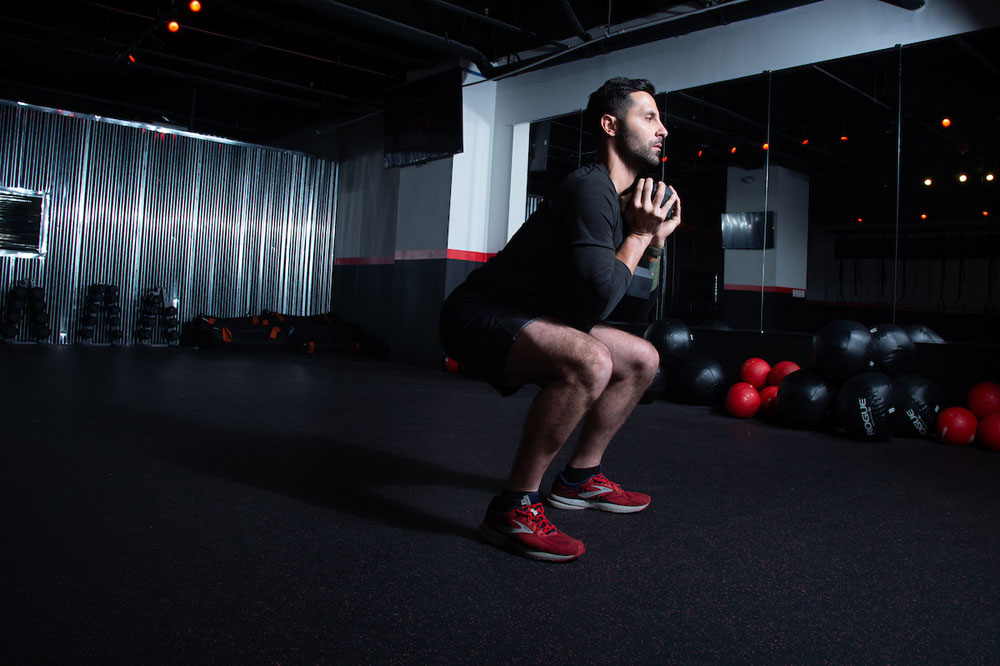5 Weightlifting Exercises Every Beginner Should Try with a Trainer, First

Let's get one thing straight: there's no such thing as a "bad exercise"—just good exercises done poorly. No one wants to be injured, but lifting with improper form, and lifting too heavy, too fast, are some of the quickest ways to get hurt. The key to avoiding injury? Work up to what your body can handle, in both form and yield. And be sure to consult the experts — tapping a trainer to coach you on form and function can go a long way.
"There are a lot of athletes who do these exercises [below] that are in solid shape, but they don't have proper core stabilization, or their hips are out of alignment, or they compensate with their back to lift heavy weights," says Spartan's Director of Fitness Sam Stauffer. "Many athletes who try these exercises aren't ready. We all get ahead of ourselves or get excited, and (in a need to prove it to ourselves) might push it too far." To stay safe, Stauffer says you need to know how to engage your glutes, keep your back straight, and avoid dumping weight in dangerous places like the neck, shoulder girdle, and low back. He also warns that your level of soreness after weightlifting doesn't determine the quality of your workout. In fact, it can be an indicator of poor form or impending injury—especially when you're new to weightlifting.
But it's impossible (not to mention, unsafe) to go from zero-to-hero lifting overnight. So to improve performance and stay injury-free, we asked for Stauffer's shortlist of weightlifting exercises to try with a trainer first, as well as other alternatives to build strength and still get results.
Related: 4 Most Common Training Injuries (And How to Prevent Them)
Pulling Exercises
1. Behind-the-neck pulldowns or behind-the-neck barbell pressing
In a world plagued with neck pain, symptomatic of our smartphone and computer culture, it's essential to protect your cervical spine and avoid weighted exercise behind the neck—like behind-the-neck pull-downs or pressing. "If you find yourself with a tight neck or a jutting forward of the head, you probably have weak neck muscles," says Stauffer. "You’re better off to just stay away from behind-the-neck exercises, [or make sure you have a knowledgable spotter]." As another option, start with simple cable or dumbbell rows until you have enough strength to repeat pull-ups. If regular pull-ups are out of reach, try band-assisted pull-ups or eccentric pull-ups to work up to a bodyweight (unassisted) pull-up.
ALTERNATIVES: Cable or dumbell row

Power-Development Exercises
2. Olympic barbell lifting
"Yes, we know, this one is a touchy subject, but here is what we have to say about Olympic lifts: at the end of the day, it comes down to risk versus reward, and for these, there is a higher risk than reward," says Stauffer. If you’re training for a competition, need excessive amounts of power, or are currently playing a competitive sport, this is a great exercise, but be sure to run your form by a certified trainer. Don't have one? You can substitute for more practical power-development exercises such as kettlebell swings, sandbag cleans, or ballistic medicine ball work. "In your early 20s, your body is more forgiving and recuperates much faster," says Stauffer. "Be extra wary with these movements if you’ve passed the 30+ mark. That said, Olympic lifts are great power exercises but need to be programmed wisely."
ALTERNATIVES: Kettlebell swings, sandbag cleans, medball work

Related: How to Improve Your Grip Strength
Shoulder and Chest Strengtheners
3. Cable flys
"This was a staple for me growing up to build major strength in the chest," says Stauffer. "Unfortunately, sometimes our anatomy can disagree with this exercise." Going too wide on a cable fly can put an excessive amount of stress on the anterior shoulder joint. While it is nice to feel the burn, it can mislead you to make you think you're building muscle, when really—without enough mobility—you're just wrecking your shoulders. Stauffer suggests when in doubt, to save your shoulders and try these three strength exercises instead, for the same result: weighted push-up, dumbbell floor press, and the anterior shoulder press.
ALTERNATIVES: Weighted push-up, dumbbell floor press, and the anterior shoulder press

Leg and Core Strengtheners
4. Deadlift
Hold tight! We are pro deadlifting and think it's are a great full-body, strength-building movement. That said, many athletes lack the proper core strength and joint mobility to execute this exercise properly, according to Stauffer. Without those two critical pieces, you dump unnecessary weight into the lower back. So while it's one of our favorite movements for overall health, it can be really dangerous if done improperly. "This is an exercise that, when done incorrectly, has a far greater negative impact than a bodyweight squat for example," says Stauffer. "For us, it’s a simple spectrum of risk versus reward, and the deadlift falls closer to the risk side." If you’re going to do it, Stauffer suggests finding a coach to teach you proper mechanics or focusing on building a strong core and working up to weights your body can handle. If you’re new to lifting or haven’t hit the gym in a while, protect your low back and start with a baseline exercise like the hip bridge. From there, you can work up to a lightweight kettlebell deadlift.
ALTERNATIVES: Hip bridge and lightweight kettlebell deadlift

Back Squats
5. Barbell backsquat
Similar to the deadlift, the barbell back squat falls on the potentially dangerous end of the Spartan risk-versus-reward spectrum. Many beginners just aren’t ready for this. "Sure, you were probably forced to do these at some point in your exercise journey—a strength room in highschool/college, or they were a staple in a lifting class—but unless you have optimal shoulder mobility, hip mobility, core stability, and ankle mobility, you’re asking for trouble with this exercise," says Stauffer. In most instances, your lower back will bear the load when it’s not meant to. As an alternative to barbell back squats, try the more refined goblet squat. Stauffer also suggests mixing it up by building strength from lunging patterns—which you can load up fairly heavy when your body is ready.
ALTERNATIVE: Traditional goblet squat

